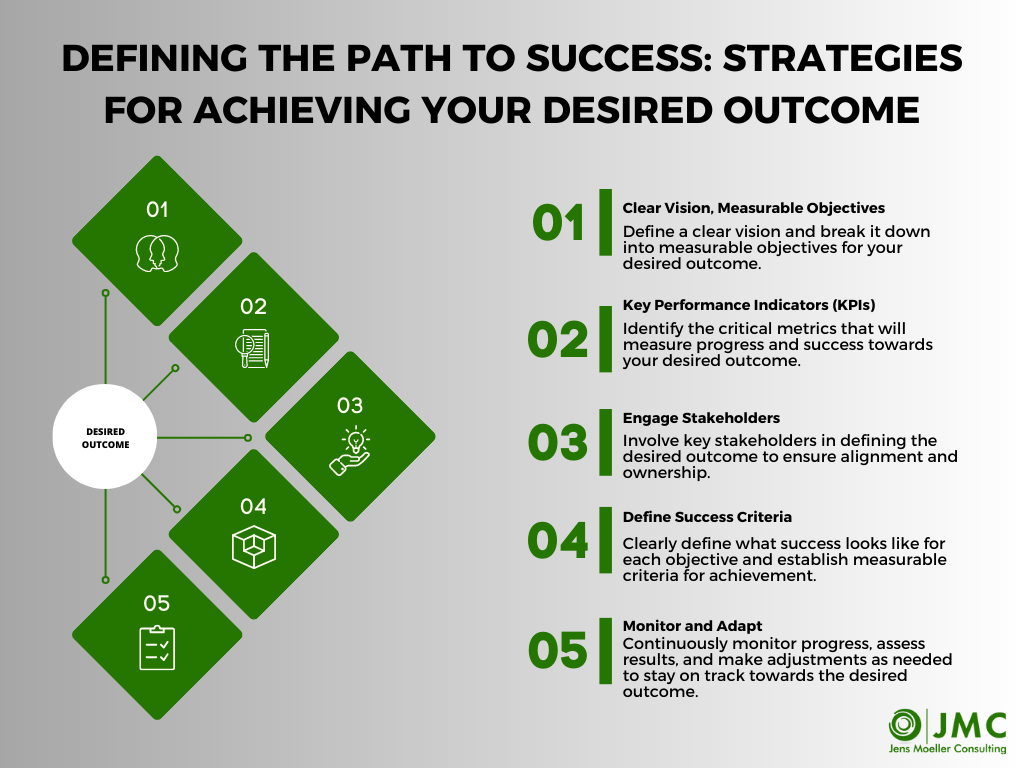Setting effective goals is essential for improving results and performance, especially in today’s virtual and challenging work environment. In this article, we will explore Jens Moeller’s valuable insights on goal setting and how it can lead to significant improvements in cooperation, productivity, and overall performance.
Setting Concrete Goals
Let’s delve into the scenario presented by Moeller to understand the significance of setting concrete goals. Imagine a company where conflicts among employees have been escalating, leading to missed deadlines, decreased productivity, and a toxic work environment characterized by blame shifting between departments. Recognizing the urgency of the situation, the managing director decides to take action by setting goals to resolve conflicts and enhance cooperation.
At first glance, the objectives may seem clear and straightforward. However, upon closer examination, Moeller prompts us to question the clarity of these goals. Are they precisely defined and easily measurable? This is a crucial consideration because vague or ambiguous goals can hinder progress and make it challenging to determine whether desired outcomes have been achieved.
To address this, let’s imagine the managing director takes a proactive approach by defining concrete goals. Instead of stating simply that conflicts should be resolved and cooperation enhanced, the goals are reframed with specific parameters and measurable criteria.
For example: Conflict Resolution Goal: Establish a conflict resolution process where conflicts are effectively addressed and resolved within a defined timeframe, minimizing the impact on productivity and fostering a harmonious work environment.Measurable criteria: Reduction in the number of reported conflicts by 30% within the next quarter. Decrease in the average time taken to resolve conflicts from 10 days to 5 days by the end of the year.
Cooperation Enhancement Goal: Foster a culture of collaboration and mutual support across departments, promoting effective communication and shared responsibility. Measurable criteria: Increase the frequency of cross-departmental collaboration initiatives by 50% within six months. Achieve a satisfaction rating of 4.5 out of 5 in the employee survey regarding perceived cooperation and teamwork by the end of the year.
By establishing these concrete goals, the managing director provides a clear direction for the entire organization. Employees understand what is expected of them, and progress can be objectively measured. Moreover, these goals help align individual efforts with the broader organizational objectives, fostering a sense of purpose and motivation among the team members.

Observable and Measurable Goals
Moeller’s insights shed light on the importance of setting observable and measurable goals. While resolving conflicts can be observed over time through indicators such as reduced arguments and complaints, the goal of improving cooperation is more abstract and challenging to measure. In order to overcome this challenge, Moeller emphasizes the need to operationalize this goal by making it tangible and quantifiable.
By asking specific questions, such as what defines improved cooperation and what joint results the team or organization wants to achieve, concrete goals can be established. Let’s explore this concept further by considering an example.
Suppose a company’s service team is responsible for handling customer requests and inquiries. The performance of this team is directly assessed by customers, who have the opportunity to provide feedback after each interaction. This feedback could be in the form of surveys or by using a metric like the Net Promoter Score (NPS), which gauges customer satisfaction and loyalty.
To make the goal of improving cooperation observable and measurable, the team can set the following goals: Decrease in Customer Complaints: Aim to reduce the number of customer complaints related to poor cooperation or internal communication breakdowns. This could be measured by tracking the number of complaints received per month and aiming for a specific reduction percentage over a defined period.
Increase in Customer Satisfaction: Set a target for improving the overall customer satisfaction score, as measured by surveys or the NPS. This can serve as an indirect indicator of improved cooperation, as satisfied customers often perceive a well-coordinated and cooperative service experience.
By defining these goals, the team can monitor their progress and make adjustments accordingly. Regularly reviewing the number of customer complaints and tracking customer satisfaction scores will provide valuable insights into the effectiveness of efforts to enhance cooperation.
Linking Goals to Results
Moeller emphasizes the need to connect goals to specific results. In the case of the service team, the desired result is improved cooperation, which should ideally be reflected in positive outcomes for the customers and the organization as a whole.
If the observable indicators, such as customer feedback scores, do not show improvement over time, it suggests that the desired level of cooperation might not have been achieved. This realization prompts the need to investigate the underlying causes.
For instance, if customer satisfaction scores remain stagnant despite efforts to improve cooperation, the team needs to delve deeper into potential process breakdowns or communication gaps. They could examine factors such as the efficiency of the delivery process, the timely placement of orders with the warehouse, or the smooth flow of information between departments.
By analyzing these underlying causes, the team can identify specific areas for improvement and implement targeted solutions. This iterative process allows for ongoing refinement and ultimately leads to the desired outcomes of improved cooperation and enhanced performance.

Identifying Process Improvements
Moeller’s example highlights a situation where critical information regarding a product replacement failed to reach the service department on time, resulting in customer dissatisfaction. Instead of simply attributing blame, Moeller encourages a deeper analysis of the underlying processes. By identifying and addressing the root causes of breakdowns, such as neglected routines, communication breakdowns, or technical issues, cooperation and results can be significantly improved.
For instance, in the scenario presented, the breakdown in communication between product development and the service department resulted in customers not receiving timely information about the product replacement. Instead of solely blaming one department or individual, a more productive approach would be to investigate why the information flow was disrupted. This could involve examining whether there were established routines for sharing information, communication channels were effectively utilized, or any technical barriers that hindered the process.
By identifying these process improvements, such as establishing clear communication channels or implementing routine reports, the team can prevent similar issues from occurring in the future. This not only enhances cooperation between departments but also improves the overall efficiency and effectiveness of the organization.
Defining the Desired Outcome
Moeller emphasizes the significance of determining the desired result of joint cooperation. While the concept of “good cooperation” may be a vision or qualitatively formulated goal, it is crucial to establish clear criteria for measuring progress. Simply stating that the goal is to improve cooperation is not enough. Instead, it is essential to define specific outcomes or indicators that reflect improved cooperation.
In the example discussed, indicators of improved cooperation could include fewer conflicts observed in communication channels, such as corridors, emails, telephone calls, and web conferences. These observations serve as tangible signs of enhanced cooperation within the team or organization. By setting these observable indicators, progress towards the desired outcome can be tracked and evaluated.

Evaluating Results and Taking Action
Regular evaluation of joint results is crucial for identifying areas of improvement and taking corrective actions. Moeller emphasizes the importance of asking critical questions and swiftly addressing the underlying causes that hinder progress.
By evaluating the outcomes and assessing whether the desired results have been achieved, teams can identify any shortcomings and areas for improvement. If the observed indicators of improved cooperation fall short of expectations, it is essential to investigate further and identify the root causes.
Taking prompt action to address these causes allows the team or organization to make necessary adjustments and improvements. This may involve implementing new processes, improving communication channels, providing additional training, or fostering a culture of collaboration and transparency.
By continuously evaluating results, asking important questions, and taking proactive action, teams can enhance cooperation, achieve better results, and drive overall performance improvement.

Jens Moeller Consulting is here to support you in enhancing your performance and achieving remarkable results through effective goal setting. We value your feedback, suggestions, and questions as we strive to provide the best guidance tailored to your unique situation.
 by Jens Moeller
by Jens Moeller